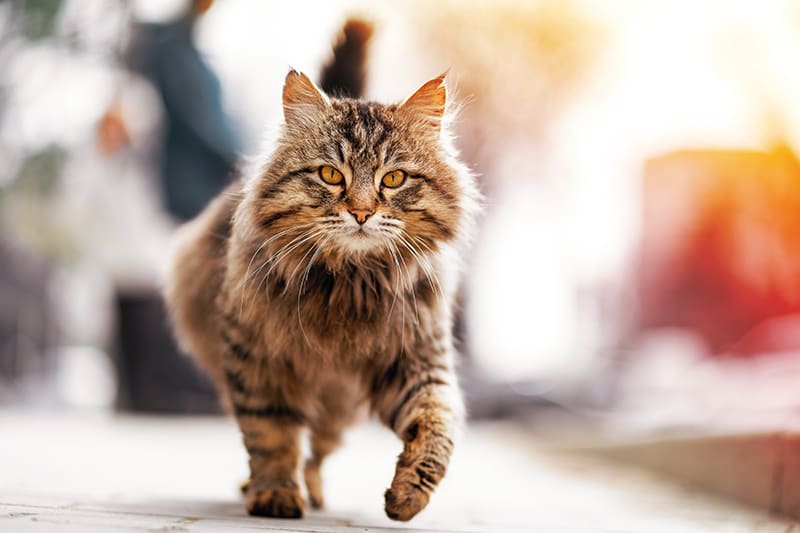My Cat is Limping
Unfortunately, our pets aren't able to tell us how they are feeling, or what hurts, which can make figuring out why your cat is limping challenging. Cats can limp for many reasons whether they are limping from their back leg, or limping from their front leg such as getting something stuck in their paw, a sprain, a break, or even an ingrown claw.
Remember, if your cat is limping it's a sign that they are experiencing pain, even if they don't look like it (cats are really good at hiding pain).
It's always best to take your cat to the vet if they have a limp in order to avoid the possibility of infection and to help keep their condition from worsening. The cause of your cat's limp might not be easy to spot but the treatment could be as simple as trimming their claws or pulling out a thorn.
That said, if you're a pet parent it's a good idea to monitor your animal's health regularly, and watching how they walk is a part of that. Always keep an eye out for swelling, redness, and open wounds. If you see any of these call a vet immediately.
Reasons Why Your Cat May Be Limping
Below we have listed a few common reasons why your cat might be limping:
- Something stuck in their paw
- Sprained or broken leg caused by trauma (being hit, falling, or landing wrong)
- Walking across a hot surface (stove, hot gravel, or pavement)
- Ingrown nail/ claw
- Being bitten by a bug or other animal
- Infected or torn nail
- Arthritis
What To Do About a Limping Cat
If your cat is limping keep them calm and relaxed as you assess their leg. Run your fingers down the site watching and feeling for any sensitive areas and keeping an eye out for open wounds, swelling, redness, and in extreme cases dangling limbs. Start at your kitty's paw and work your way up.
If it is something such as a thorn gently pull the thorn out with tweezers and clean the area with soap and water. Be sure to keep an eye on the area to ensure that an infection doesn't take hold as the puncture wound heals. If overgrown nails are the issue simply trim your cat's nails as usual (or have it done by your vet).
If you are unable to figure out the cause of the limp and your beloved kitty is still limping after 24 hours make an appointment with your vet.
It could be hard to tell if your cat's leg is broken because the symptoms could mirror other injuries or a sprain (swelling, a limp, leg being held in an odd position, lack of appetite) which is why it's always best to call your vet.
While waiting for your veterinary appointment you have to limit your cat's movements to keep them from causing further injury or making it worse. Do this by keeping them in a room with low surfaces, or putting them in their carrier. Make sure they are comfortable by providing them with a comfy place to sleep/kitty bed and keeping them warm with their favorite blankets. Continue to monitor their situation.
When You Should Take Your Cat to The Vet
It is always a good idea to take your cat to the vet for limping to prevent infection or get a proper diagnosis. If any of the following situations apply to your cat make an appointment with your vet:
- You can't identify the cause
- They have been limping for more than 24 hours
- There is swelling
- An open wound
- The limb is dangling in an odd position
Don't wait 24 hours if there is a visible cause such as bleeding, swelling or the limb is hanging in a strange way, call your vet immediately to prevent infection or a worsening condition. You should also call your vet if you do not know how to handle the situation, your vet will be able to give you advice on the actions you should take next.
Note: The advice provided in this post is intended for informational purposes and does not constitute medical advice regarding pets. For an accurate diagnosis of your pet's condition, please make an appointment with your vet.
If your cat is limping contact us to book an examination for your feline friend. Our experienced vets can diagnose the cause of your cat's limp and provide effective treatments to help get your cat walking normally again.

Looking for a vet in Southeast Memphis?
We're always accepting new patients, so contact our veterinary hospital today to book your pet's first appointment.
Related Articles View All
Signs, Causes & Treatments for Ear Mites in Cats
Ear mites cause uncomfortable irritation to a cat's ears and skin, but with diligent care, this parasite is fairly straight forward to treat. Here, we explain how to spot the signs of ear mites in cats and how ear mites can be treated.
Where to Leave a Cat While on Vacation
If you're a cat parent, at some point you are likely to face the dilemma of where to leave your cat when you go on vacation. Today's post offers a few suggestions for you to consider.
Cat Tooth Extractions - A Pet Parent's Guide
If your cat has a damaged or diseased tooth a dental extraction may be required. Today, our Memphis vet dentists discuss the reasons that your cat may need to have a tooth removed and what you can expect if they require tooth extraction surgery.
Why does my cat have diarrhea?
Diarrhea in cats is a common issue seen by our Memphis vets. Here are some of the most common causes of cat diarrhea, as well as advice on when a trip to the vet is called for and how to stop your cat's diarrhea.
